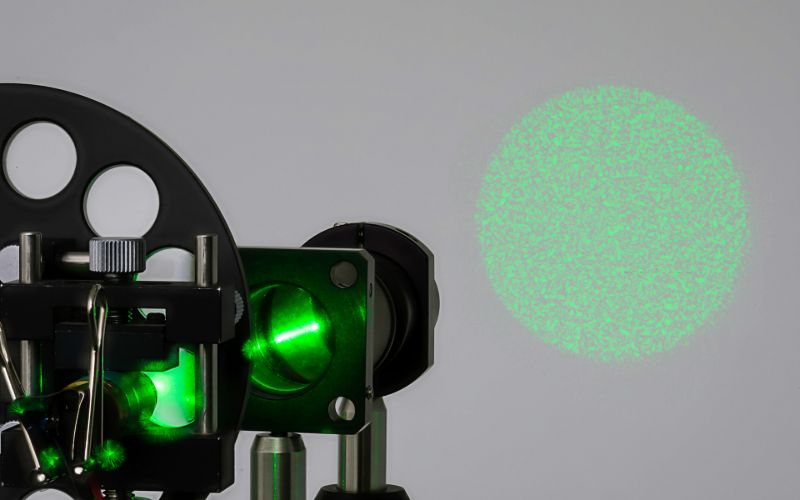Optical homogenizer definition
An optical homogenizer is an optical component that makes the intensity profile of a light beam more uniform. This means that local intensity variations in the beam profile are eliminated, and the overall envelope of the beam becomes smooth.
Homogenizer working principle
Homogenization is done by means of diffusing the light at controlled angles, scrambling the phase and creating a controlled divergence. Each point on the wavefront of the beam thus becomes a source with diverging angles, and the overlapping of these points at the far field creates a more uniform intensity pattern.
This does not mean there cannot be speckle, or high frequency noise, inside the beam profile- for highly temporally coherent sources, overlapping the beams results in dips in the intensity due to interference effect. For less coherent sources, such as high M2 lasers or LEDS, the overlapping does not result in strong interreference, and the intensity shape achieved by the optical homogenizer becomes smooth. The precise shape of the intensity envelope is determined by the homogenizer definition – As a rule, there are several types.
Homogenizer definition by intensity profile
There are in general two groups of homogenizers, the random scattering type vs. the controlled scattering type.
- Random scattering diffusers work by creating a random phase profile with some typical scale on the beam front. This can be done by rough ground glass surfaces, or a material that has volume scattering such as opal glass. This sort of homogenizer, while still technically within the homogenizer definition, is highly limited. It can only generate a gaussian beam profile, and control of angles is often limited by the statistics of the scattering sources on the homogenizer surface. Their main advantage is low cost, and they are often used in lighting applications, where sources have high divergence angles and are incoherent, thus exact control of the illumination profile is less critical than uniformity.
- Controlled scattering homogenizers, also called beam shaping diffusers, are what most users think of when asked for a laser homogenizer definition. These are highly defined phase surfaces that scatter the light in pre-defined angles and intensity ratios per angle. This can be done by a diffractive optical element (DOEs), a micro lens array or broadband diffuser homogenizers, such as Holo/Or’s BD.
A laser beam homogenizer is almost always of a controlled scattering type, as the gaussian output of random diffusers is not optimal for most laser processes and applications.

Comparison of laser beam homogenizer types
As stated, there are three main groups of diffusers used for laser homogenization.
- Refractive diffusers, such as micro lens arrays , are polychromatic (work at all wavelengths where the material is transparent), and have high efficiency. However, they tend to have tolerances on diffusion angles due to the production process, and have periodic artifacts inside the illumination pattern due to the micro lenses fixed pitch. Also, edge sharpness is often limited by the micro lenses pitch.
- Diffractive diffusers at monochromatic, and work only at the design wavelength. However, they have diffraction-limited edge sharpness, and absolute angular accuracy due to their lithographic production process. They also have complete shaping freedom, unlike refractive diffusers that are limited by the micro lens packing. This makes them especially useful for high-end laser applications which require precise diffusion angles, such as laser industrial processing and aesthetic laser treatments.
- Broadband Diffusers combine the advantages of the complete shaping freedom of diffractive diffusers, with the polychromatism and high-efficiency of refractive diffusers. This is done by defining a surface that has both refractive and diffractive scattering of the light. A Broad band diffuser homogenizer can be useful for applications such as thermal treatment, welding and surface annealing.
It is important to keep in mind the homogenizer definition is system related – a component that acts as a dot array generator (diffractive multi-spot or micro lens array) can work as a homogenizer, by using defocus or reducing beam size.
TL; DR - Q&A summary
what is an optical homogenizer?
The optical homogenizer definition is as follows: a homogenizer is an optical component that makes the beam propagated through it more uniform at the far field.
What is the operating principle of a homogenizer?
A homogenizer works by scrambling the phase of the beam passing through it, scattering the beam hitting it so that each point on the beam front is scattered over many angles and overlaps the scattering from other points. This overlapping of creates a uniform intensity profile.
What types of homogenizers are there?
In the lower end, there are random scattering diffusers such as ground glass and opal glass diffusers. These make only gaussian profiles and are mostly used in illumination. In the high-end are beam shaping diffusers, that can generate flat- top distributions and any desired shapes.

